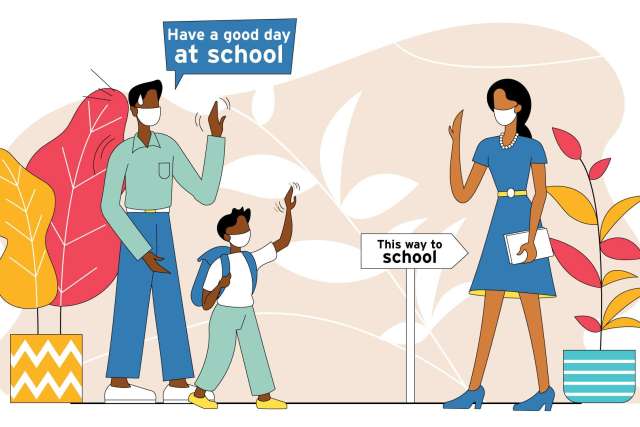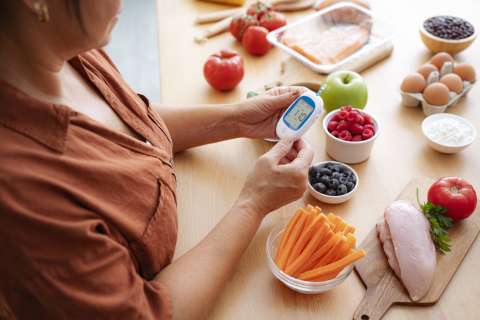Note: This story was updated on April 12, 2021.
For the past year, school has been a mostly digital, isolated experience for students across Los Angeles County.
But change is on the way. With the county’s COVID-19 positivity rate declining, the county’s largest school district, Los Angeles Unified, is beginning a phased reopening, with 72 campuses welcoming kindergarteners and first graders back on Tuesday, April 13. Another 508 elementary campuses will reopen the week of April 19, followed by 262 middle and high schools the week of April 26.
LAUSD surveys showed an estimated 40% of elementary school students are planning to come back for in-person instruction.
Masks are required for all returning students and staff. Students must have a COVID-19 test — which are being provided free throughout the district — before coming back to school. Follow-up testing and contact-tracing will be conducted on campuses.
Students — or their parents for them — also must answer daily symptom screening questions online or in person before coming to class.
Physical distancing will be practiced on all campuses and in classrooms, where desks will be kept six feet apart. LAUSD teachers and staff members have been offered COVID-19 vaccines.
LAUSD Superintendent Austin Beutner announced on April 12 that the district is considering adding two weeks to the school calendar to address learning loss suffered during pandemic closures.
Many other school districts throughout the county have already brought students in all grades back for in-person learning, though some families have opted to continue remote studies. Reopened schools in Los Angeles County will continue to offer 100% online learning opportunities.

Shangxin Yang, PhD, an assistant clinical professor of pathology at the David Geffen School of Medicine at UCLA and father of a fourth-grader, says he’s optimistic about the decline of COVID-19 cases in Los Angeles County and what the long-awaited return to school means for local students.
“When you look at the community, all the rates are going down in a very dramatic fashion,” he says. “In the meantime, there’s a lot more solid evidence suggesting that reopening schools with multiple mitigation strategies actually works with very minimal, rare outbreaks in schools.”
A paper published in January in the Journal of the American Medical Association reports “little evidence that schools have contributed meaningfully to increased community transmission” of COVID-19. In one rural Wisconsin school district with more than 4,800 students and 650 staff, for example, there were 191 cases in the fall, but only seven were found to result from in-school transmission.
“Overall risk is really tied to community prevalence,” Dr. Yang says. “When the whole community’s positivity rate is dropping, then the risk is much lower, no matter if it’s in a bus or in a classroom or in a school.”

Keeping schools safe, however, isn’t just up to students, teachers and administrators. It requires that family and household members of anyone spending time on campus commit to masking, physical distancing and limiting their social interactions, just like students and teachers at school, says Anuradha Seshadri, MD, MS, a pediatrician and internist at UCLA Health.
A “layered approach” that includes wearing masks, washing hands often, physical distancing, increased ventilation, frequent cleaning of high-touch surfaces and limiting interaction between student groups is key to preventing virus spread in schools, Dr. Yang says. County, state and national health school-reopening protocols have these elements built in.
A comprehensive approach is so important that the Centers for Disease Control and Prevention’s toolkit for mitigating COVID-19 in schools is 36 pages long and includes multiple detailed checklists. There are protocols for at-home COVID-19 screenings, navigating shared spaces such as hallways and bathrooms, dealing with staff or students who get sick, how often surfaces must be cleaned and by whom, how meals will be distributed, where staff and students should store their masks while eating, accessing touch-free trash cans and water fountains and what kind of ventilation is required for various rooms.
Classrooms must meet ventilation standards and everyone on campus will be required to wear masks. Each classroom will comprise a stable cohort of students and teachers that allows for optimal physical distancing of at least six feet. All on-campus activities — learning, recess, lunch — will take place within the same group.
For families with kids returning to campus, here are other considerations for safely getting through the school day:
Getting to school
Walking or carpooling with members of the same classroom cohort is the safest option, Dr. Yang says. “In terms of transportation, I think the school bus would still be the highest risk, simply because of crowded conditions onboard,” he says. “Limitation of how many passengers can be on the bus at the same time can minimize the risk. Obviously, everyone needs to put on a mask and they have to physically distance, and roll all the windows down.”
Dr. Seshadri suggests schools appoint a bus “supervisor” who can make sure kids maintain their distance and keep their masks on.
In the classroom
Keeping students in fixed cohorts with the same classmates and teachers for all on-campus activities prevents infection and supports effective contact tracing, Dr. Yang says. Limiting interaction between students decreases the risk of infection, he says, and any that occur would be “limited to that group and much less likely to spread to other groups on campus.”
This also makes contact tracing easier: “You can just quarantine and test the group that you know are always interacting with each other,” he says.
Though the same cohort of students will be learning together and spending recess and lunchtime together, physical distancing and masking are still essential, Dr. Yang says.
“You can’t just count on one thing, because nothing is perfect,” he says. “You really need multiple layers of strategies, including how you limit the group. But on top of that, you still need to have masks. You still need to practice social distancing. You have to do multiple things to minimize the risk.”
It’s important to note that these classroom cohorts actually include the family and household of each student as well, adds Dr. Seshadri. “The school is only going to be as safe as those that are involved with it,” she says. “You can’t just put this on the schools. It’s your responsibility as a family member for that child you are sending to school.”
Open communication between schools and parents, and teachers and students, about adherence to health guidelines is essential, Dr. Seshadri says. Infection can be introduced into even the safest schools following CDC protocols if a family member of a student or staff member is exposed to the virus and brings it home.
Teachers can help young students comply with safe practices by making them into a game. For instance, children who wear their mask all day and follow all the protocols can earn stickers for their good behavior and at the end of the week, the student with the most stickers wins a prize.
“It’s positive reinforcement about COVID and staying safe,” Dr. Seshadri says. “It helps kids at that age to understand that it’s not just about themselves. It’s protecting other people — people and friends that they care about, and their family members, too.”
Teachers might also consider establishing “teacher zones” to encourage students to keep their distance from adults in the classroom, she says.
She advises against sharing books, art supplies and other items in the classroom, though Dr. Yang notes that such behavior isn’t typically high risk.
“We don’t want to advocate for people to share things, but if they have to, I think very minimal sharing should be fine,” he says. “The main transmission is not really through contact — it’s through droplets or airborne. So if people are wearing masks and wash their hands after they touch things, that risk is pretty low.”
Shared spaces
Markings on the floor that denote proper physical distance are a good idea for shared spaces such as hallways and locker bays. Staggering access to lockers — and keeping cohort-members’ lockers six feet apart — can prevent students from crowding the area. Kids should also wash their hands before and after touching their lockers, which should be wiped down frequently, Dr. Seshadri says.
Cafeteria access should be limited and meals should be pre-packaged, according to CDC guidelines. Water fountains are high-touch areas, so parents should consider sending students to school with their own refillable water bottles. “If there is a shared water fountain, it should be cleaned frequently,” Dr. Seshadri says.
The most likely location for virus transmission is the staff lounge, Dr. Yang says. “That’s a time when people start eating and they feel relaxed. They have to take off the mask to eat or drink, and then they might want to chat a little bit,” he says. “People should not share food and they shouldn’t really be talking while they are eating, to be honest. Once they take off their mask, they should be just eating and if they want to talk, they should put the mask back on.”
After school
The biggest risk of transmission is outside the school setting, Dr. Yang says, which is why students’ families must follow health protocols as well. “Usually what we see is the adults transmit to the kids, not the other way around,” he says. “Adults may be going out for work or for social events. So when they get back to their families, they just have to be very vigilant about their own condition.”
Children who share their household with elderly or otherwise vulnerable adults might be advised to shower and change clothes before socializing with them after school.
Symptoms and dangers
Children can contract COVID-19, though they are most often asymptomatic, experts say. Dr. Seshadri suspects this is why there is so little child-to-child transmission: even infected kids don’t exhibit the coughing and sneezing seen in adults with COVID-19.
Pediatric symptoms are “very subtle,” Dr. Yang says, and could appear as a mild sore throat, if anything at all. “They don’t feel terrible,” he says. “We’ve seen cases where we had a child diagnosed and the parents couldn’t even believe it.”
Kids who have been infected with COVID-19 are vulnerable to multi-system inflammatory syndrome in children, or MIS-C, a serious condition that requires medical attention. “It’s very rare,” says Dr. Seshadri, “and, thankfully, it’s treatable.”
MIS-C can affect children between the ages of 2 and 15 up to four weeks after COVID-19 exposure, she says. “It's a little bit alarming because kids don't show symptoms, even if they are currently infectious for COVID-19, and then what pops up weeks later is potentially MIS-C.”
Children who exhibit a fever higher than 100.4 degrees for more than a day along with one of the following symptoms – unusual fatigue or weakness, red rash, abdominal pain, diarrhea, red and cracked lips, red eyes, or swollen hands and feet – should be seen by a doctor right away, Dr. Seshadri says. She adds that watching for symptoms in their children is another area where parents need to be vigilant.
“We’re still learning a lot more about this virus,” she says. “We’re still learning a lot more about the vaccine. We’re all trying to go back to a new normal, but everybody needs to be patient and everybody needs to be responsible for this to really work.”
Learn more about COVID-19 and the vaccines.
Related articles
Back to the classroom: Communication is key for preparing children to return to school
What to expect from the second dose of the coronavirus vaccine
You've gotten the COVID-19 vaccine - now what? Is it safe to return to a normal routine?
What is behind the lingering effects for some people who contracted COVID-19?




